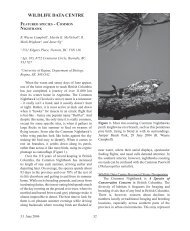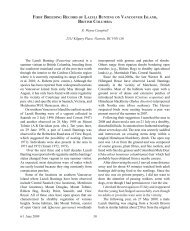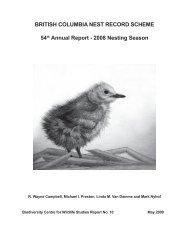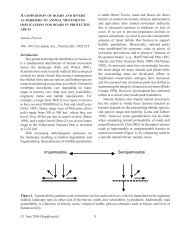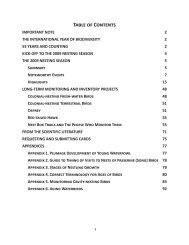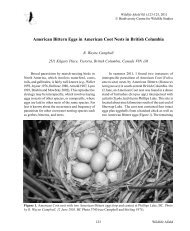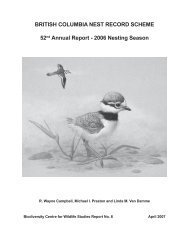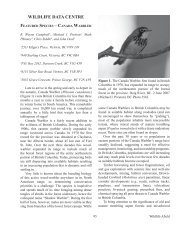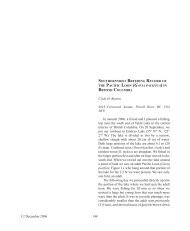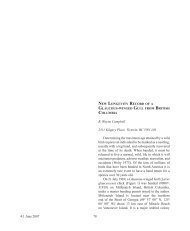2010 Nesting Season - Biodiversity Centre for Wildlife Studies
2010 Nesting Season - Biodiversity Centre for Wildlife Studies
2010 Nesting Season - Biodiversity Centre for Wildlife Studies
You also want an ePaper? Increase the reach of your titles
YUMPU automatically turns print PDFs into web optimized ePapers that Google loves.
Publications in Short<br />
Each year thousands of articles on birds are<br />
published in scientific journals and obscure<br />
reports that most of us do not see. Many of the<br />
papers are helpful to nest-finders to assist in<br />
their search <strong>for</strong> nests and broods, to understand<br />
the ecological associations of nesting birds, to<br />
learn about adaptations of body structures,<br />
and to better appreciate some of the problems<br />
facing ornithologists and the dedication that is<br />
required <strong>for</strong> their research.<br />
We have listed a few articles below that<br />
should be of interest to participants.<br />
Coots Use Hatch Order to Learn to<br />
Recognize and Reject Conspecific Brood<br />
Parasitic Chicks<br />
“Crazy as a Coot” may not apply considering<br />
the recent findings by ornithologists Daizaburo<br />
Shizuka and Bruce Lyon. The team studied<br />
American Coot behaviour at Westwick<br />
Lakes in the Cariboo region of the province to<br />
determine how the species was able to foil other<br />
coots that laid eggs in their nests and reject<br />
imposters. They found that coots can actually<br />
count their own eggs and reject others that are<br />
laid in their nests by other coots. They can also<br />
tell the difference between their own chicks and<br />
imposters (Figure 146). They do this by learning<br />
to recognize their own chicks each year by<br />
using the first hatched chick as a template <strong>for</strong><br />
identification. If the chick is not their own they<br />
will attack and frequently kill the intruder. The<br />
researchers also learned that in an average<br />
year about half of chicks in a brood will die of<br />
starvation.<br />
Nature 463:223-226, <strong>2010</strong>.<br />
Figure 146. A pair of nesting American Coots<br />
can not only count their own eggs and know<br />
when a neighbour has added extra eggs and<br />
reject them but also will attack (and frequently<br />
kill) <strong>for</strong>eign chicks if they hatch in their nest.<br />
Elizabeth Lake, BC. 7 July <strong>2010</strong> (Photo by<br />
Brent Wellander).<br />
Movements and Resource Selection of<br />
Fledgling Goshawks in Montane Forests of<br />
Southeastern British Columbia<br />
Over the past decade, concern over the<br />
impact of logging activities on Northern<br />
Goshawk nesting habitat in mature to oldgrowth<br />
<strong>for</strong>ests throughout British Columbia<br />
has been a growing concern to wildlife<br />
managers. Most interest has been concentrated<br />
on the area immediately surrounding a nest<br />
site <strong>for</strong> the period of nest-building to fledging.<br />
The present study, by W. Harrower, K. Larsen,<br />
and K. Stuart-Smith, added a new dimension<br />
to management plans that included the little<br />
known period from fledging to post-fledging<br />
and independence.<br />
In southeastern BC, radio-tagged fledgling<br />
Northern Goshawks remained within 298<br />
metres of the nest during the first 21 days<br />
and within 525 metres between 21 days and<br />
dispersal from the territory. Each post-fledging<br />
area averaged 36.7 hectares in size and juveniles<br />
favoured <strong>for</strong>ests 40 years<br />
old with high crown closure and half of the<br />
area should be <strong>for</strong>est >80 years old.<br />
Journal of <strong>Wildlife</strong> Management 74(8):1768-1773,<br />
<strong>2010</strong>.<br />
80



